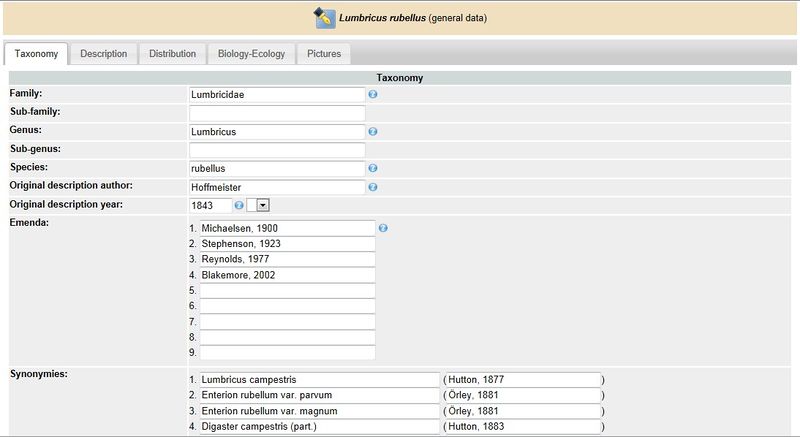From DriloBASE Taxo
 |
Content of the database ▪ Inputting data ▪ Basics of the wiki language ▪ Upload a picture ▪ User pages ▪ Profile and preferences ▪ Intranet ▪ Advanced functions |
Inputting data
Contents |
- To modify the content of a page, click up right on the "Edit" tab (see figure 1a). To save your modifications, click on "Save", at bottom left of the page (figure 1b). "Show preview" shows the page including your modifications but without saving it, and "Show changes" shows your modifications also without saving it (figure 1b).
- History tab (figure 1a) allows to see the history of modifications of the current page, including contributor name(s) and time(s) of modifications.
- Watch tab (figure 1a) allows a contributor to include the current page to his personal "watchlist". Thus, any modification carried out on this page by any other contributor will be directly viewable in real time, with also contributor name(s) and time(s). To access the Watchlist, click down of the left navigation column (in your Personal tools).
Species pages
Each species page is divided in 3 sections materialized by 3 tabs: "General data", "Thematic references" and "Distribution references" (figure 2). To each section corresponds an input form. The "General data" input form is divided in several tabs to facilitate the data inputting (figure 3).
For each species, at the bottom left of the input form (figure 4), a direct link can be established with the corresponding species of the "Earthworm Barcode of Life" (iBOL) initiative. Then the iBOL species number must be entered into the corresponding box and can be obtained with the web address. For example, the iBOL web address for Lumbricus rubellus is: http://www.earthwormbol.org/species.php?id=4532. Thus, the species number is 4532.
The "General data" section contain text, and correspond to general informations on the species, while the "Thematic references" and "Distribution references" sections must contain only bibliographical references. To facilitate the future evolution of the database, with an extended bibliographic reference management system, all references should be entered without diacritics or diacritical signs (acute accent, grave accent, circumflex, cedilla). Only the scandinavian "Ø" as first capital letter of a family name is accepted, since it is an additional letter to the latin alphabet. For a complete overview on how to input data in a species page, please see the 3 model species pages : Lumbricus rubellus, Lumbricus terrestris and Eisenia fetida.
Family and genus pages
Unlike the species pages, family and genus pages have only a single tab, divided in 4 sub-sections: "Taxonomy", "Short description", "Distribution" and "Biology-Ecology". The form must be filled by a text offering a general overview of the different aspects of the concerned taxon. At the end of each sub-section, a list of the main bibliographical references can be given.
See: Lumbricidae and Lumbricus.
References pages
Alphabetical reference lists (figure 5) are accessible by the "Bibliography" link, up of the left navigation column. Please, use the wiki code to enter or modify references and take into account the input format. A new reference with already existing similar author(s) and year should be completed with a letter. For example, if "Righi, 1984" already exists, then the next reference with similar author and year should be "Righi, 1984b", "c" for the next one, etc (see below).
Input format
Please, enter the bibliographical references as follows:
- Article:
- What you write:
- # '''McKey-Fender, D., Fender, W.M., 1982'''. ''Arctiostrotus'' (Gen. Nov.). Part. 1. The identity of ''Plutellus perrieri'' Benham, 1892 and its distribution in relation to glacial refugia. Megadrilogica, 4(3): 81-85.
- What you obtain:
- McKey-Fender, D., Fender, W.M., 1982. Arctiostrotus (Gen. Nov.). Part. 1. The identity of Plutellus perrieri Benham, 1892 and its distribution in relation to glacial refugia. Megadrilogica, 4(3): 81-85.
- Book chapter:
- What you write:
- # '''Righi, G., 1984h'''. On some earthworms (Oligochaeta, Glossoscolecida) from the Sierra Nevada de Santa Marta (Colombia). In "Studies on tropical Andean Ecosystems, 2" by Van der Hammen, T., Ruiz, P.M. (eds), J. Cramer, Berlin, pp. 455-468.
- What you obtain:
- Righi, G., 1984h. On some earthworms (Oligochaeta, Glossoscolecida) from the Sierra Nevada de Santa Marta (Colombia). In "Studies on tropical Andean Ecosystems, 2" by Van der Hammen, T., Ruiz, P.M. (eds), J. Cramer, Berlin, pp. 455-468.
- Book:
- What you write:
- # '''Lavelle, P., Spain, A.V., 2001'''. Soil Ecology. Kluwer Academic Publishers, 654 pp.
- What you obtain:
- Lavelle, P., Spain, A.V., 2001. Soil Ecology. Kluwer Academic Publishers, 654 pp.
Writing language
All bibliographical references must be written in latin writing. However, it is recommanded to write eventual non-english references using the original diacritics (such as the spanish ñ, the czech č or the polish ę) and the specific letters (such as the Scandinavian å or ø, or the german ß). When you edit a text, a standard edition keybord is selected by default (figure 6).
If desired, you can change it for an edition keybord corresponding to a specific writing (figures 7a to 7c, here for Scandinavian, Spanish and Czech).







